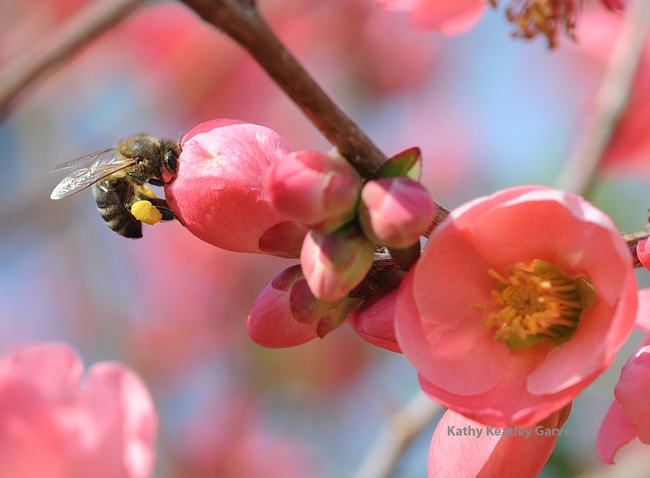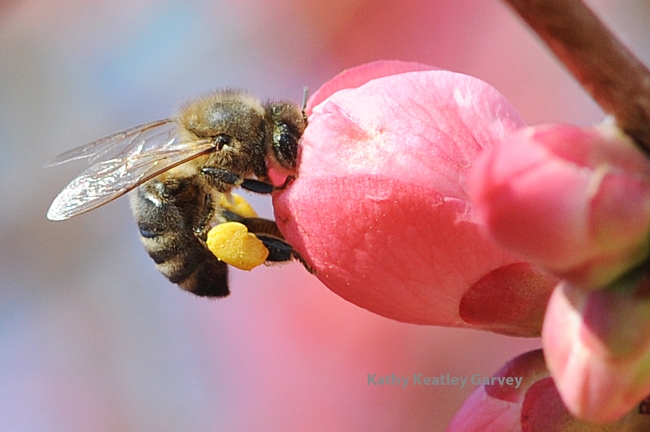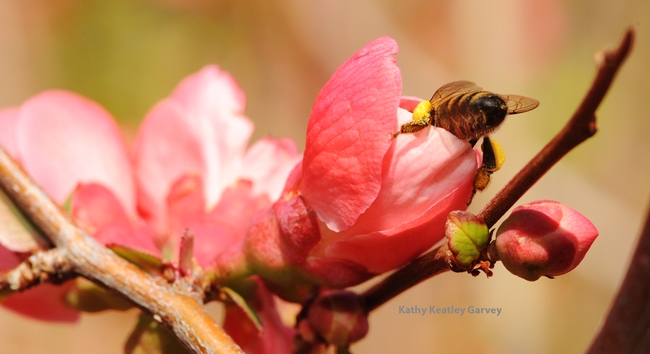A sure sign that winter is nearly over: when the flowering quince bursts into bloom, attracting a flotilla of foraging honey bees.
Actually, the bees began "inspecting" the flowering quince in the bud stage. "Hurry, open up!" the bees seemed to urge. "We have to start feeding our colonies."
Flowering quince (genus Chaenomeles, family Rosaceae) is an ornamental plant that's delightful to see. Who doesn't admire the soft pink blossoms and the comforting hum of bees buzzing around with heavy loads of yellow pollen?
The nation's bees, though, are still in trouble. Overwintering losses are still around 30 percent as in the years past, honey bee experts say. Bees are still suffering from colony collapse disorder (CCD), a mysterious malady characterized by adults bees abandoning the hive. CCD is thought to be the result of multiple factors, including pesticides,pests, diseases, malnutrition and stress.
As Christi Heintz, executive director of Project Apis m. (as in Apis mellifera), told the Almond Board of California at its meeting in December: “Colony losses are not quite as acute as in previous years, mainly as a result of improved management, but overwintering losses still hover around 30 percent, an unsustainable rate of loss.”
Heintz, who is the Almond Board Bee Task Force liaison, listed seven areas for best management practice (BMP) development: bee nutrition, pest control/varroa, disease control/nosema, hive mangement/equipment, colony management, business management, and BMPs for almond growers/bee rentals.
You can read the entire BMP article in Bee Culture.
Project Apis m. or PAm, serves an important role. Beekeepers and orchardists established PAm in December 2006, as a "New Vision" to fund honey bee research on managed colonies, according to its website. The organization's goal: "to fund and direct research to improve the health and vitality of honey bee colonies while improving crop production. Emphasis is placed on research studies that have realistic and practical usefulness for beekeeping businesses."
"PAm brings together representatives of the American Honey Producers Association (APHA), the American Beekeeping Federation (ABF), the National Honey Board (NHB), California State Beekeepers Association (CSBA), and California almond farmers. PAm includes representatives from both the pollination and crop production enterprises."
Together we can all do our part to help save the bees. The first step: awareness.
Attached Images:

Honey bee visiting flowering quince. (Photo by Kathy Keatley Garvey)

Close-up of bee visiting flowering quince. (Photo by Kathy Keatley Garvey)

Upsy daisy! (Photo by Kathy Keatley Garvey)